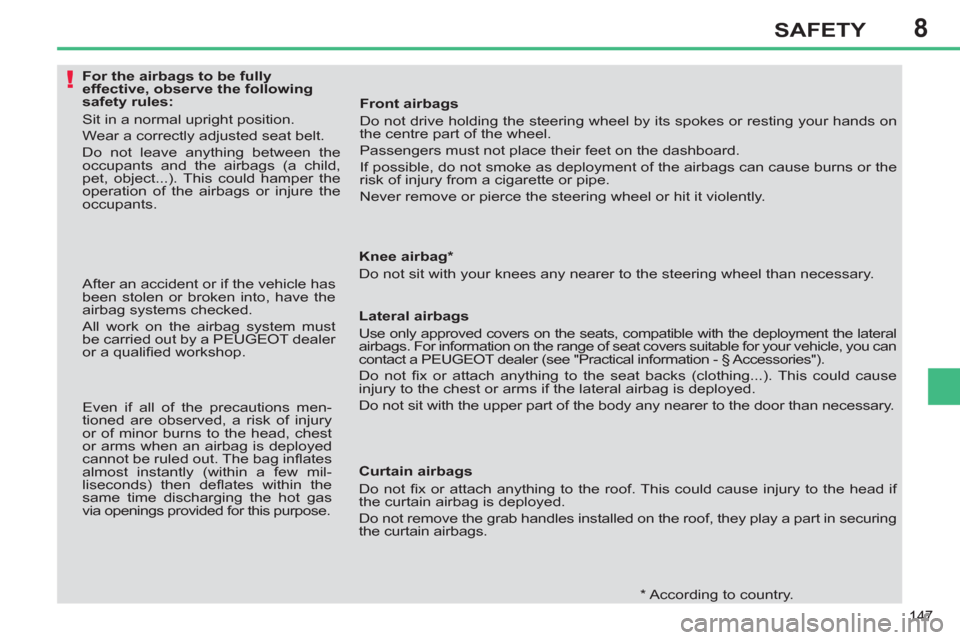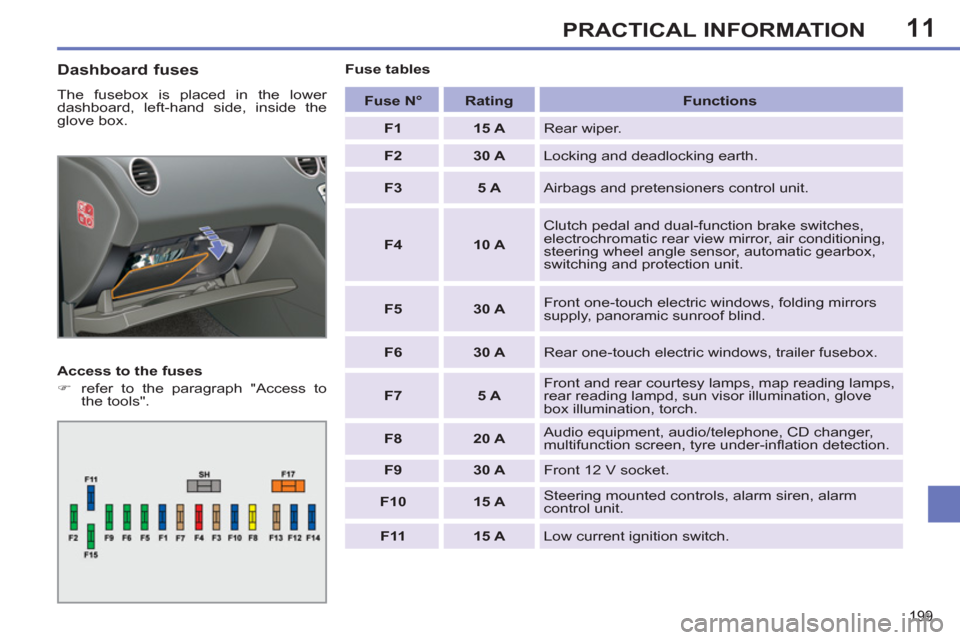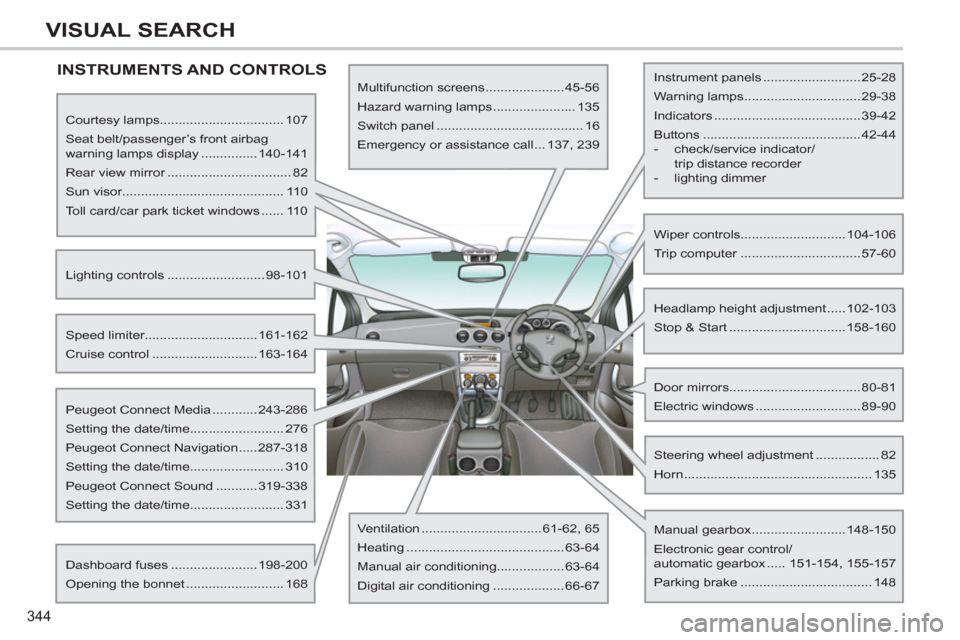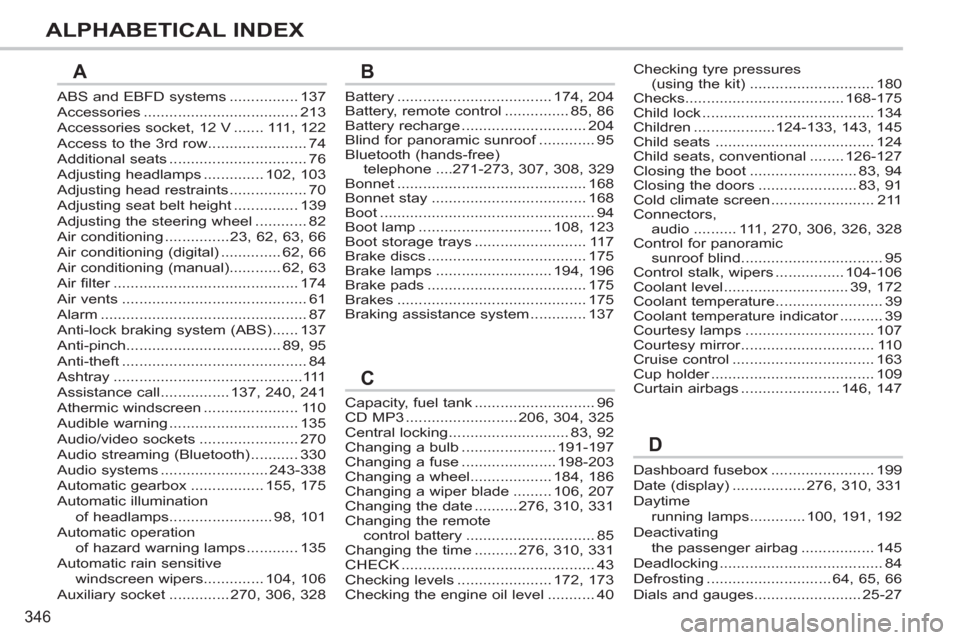2011 Peugeot 308 SW BL dashboard
[x] Cancel search: dashboardPage 149 of 356

8
!
147
SAFETY
For the airbags to be fully
effective, observe the following
safety rules:
Sit in a normal upright position.
Wear a correctly adjusted seat belt.
Do not leave anything between the
occupants and the airbags (a child,
pet, object...). This could hamper the
operation of the airbags or injure the
occupants.
*
According to country.
Knee airbag *
Do not sit with your knees any nearer to the steering wheel than necessary.
Lateral airbags
Use only approved covers on the seats, compatible with the deployment the lateral
airbags. For information on the range of seat covers suitable for your vehicle, you can
contact a PEUGEOT dealer (see "Practical information - § Accessories").
Do not fi x or attach anything to the seat backs (clothing...). This could cause
injury to the chest or arms if the lateral airbag is deployed.
Do not sit with the upper part of the body any nearer to the door than necessary.
Curtain airbags
Do not fi x or attach anything to the roof. This could cause injury to the head if
the curtain airbag is deployed.
Do not remove the grab handles installed on the roof, they play a part in securing
the curtain airbags.
After an accident or if the vehicle has
been stolen or broken into, have the
airbag systems checked.
All work on the airbag system must
be carried out by a PEUGEOT dealer
or a qualifi ed workshop.
Even if all of the precautions men-
tioned are observed, a risk of injury
or of minor burns to the head, chest
or arms when an airbag is deployed
cannot be ruled out. The bag infl ates
almost instantly (within a few mil-
liseconds) then defl ates within the
same time discharging the hot gas
via openings provided for this purpose.
Front airbags
Do not drive holding the steering wheel by its spokes or resting your hands on
the centre part of the wheel.
Passengers must not place their feet on the dashboard.
If possible, do not smoke as deployment of the airbags can cause burns or the
risk of injury from a cigarette or pipe.
Never remove or pierce the steering wheel or hit it violently.
Page 200 of 356

11
!
i
198
PRACTICAL INFORMATION
PEUGEOT will not accept responsi-
bility for the cost incurred in repairing
your vehicle or for rectifying malfunc-
tions resulting from the installation
of accessories not supplied and not
recommended by PEUGEOT and
not installed in accordance with its
instructions, in particular when the
combined consumption of all of the
additional equipment connected ex-
ceeds 10 milliamperes.
Installing electrical accessories
Your vehicle’s electrical system is
designed to operate with standard
or optional equipment.
Before installing other electrical
equipment or accessories on your
vehicle, contact a PEUGEOT deal-
er or a qualifi ed workshop.
CHANGING A FUSE
Access to the tools
The extraction tweezer is fi tted to the
back of the dashboard fusebox cover.
For access to it:
�)
open the glove box lid,
�)
push the opening guide to the left to
open to beyond the fi rst notch,
�)
open the glove box lid fully,
�)
turn the screw a quarter of a turn to
the left,
�)
unclip the fusebox cover by pulling
at the top right,
�)
remove the cover completely and
turn it over,
�)
remove the carrier in which is fi tted
the tweezer.
Changing a fuse
Before changing a fuse, it is necessary to:
�)
identify and rectify the cause of the
failure,
�)
switch off all electrical consumers,
�)
immobilise the vehicle and switch
off the ignition,
�)
identify the failed fuse using the
tables and diagrams on the following
pages.
To replace a fuse, it is essential to:
�)
use the special tweezer to extract
the fuse from its housing and check
its fi lament.
�)
always replace the failed fuse with
a fuse of the same rating (same
colour); the use of a different rating
may cause malfunctions (risk of
fi re).
If the fault recurs soon after changing
the fuse, have the electrical system
checked by a PEUGEOT dealer or a
qualifi ed workshop.
Good
Failed
Tweezer
Page 201 of 356

11
199
PRACTICAL INFORMATION
Dashboard fuses
The fusebox is placed in the lower
dashboard, left-hand side, inside the
glove box.
Access to the fuses
�)
refer to the paragraph "Access to
the tools".
Fuse tables
Fuse N°
Rating
Functions
F1
15 A
Rear wiper.
F2
30 A
Locking and deadlocking earth.
F3
5 A
Airbags and pretensioners control unit.
F4
10 A
Clutch pedal and dual-function brake switches,
electrochromatic rear view mirror, air conditioning,
steering wheel angle sensor, automatic gearbox,
switching and protection unit.
F5
30 A
Front one-touch electric windows, folding mirrors
supply, panoramic sunroof blind.
F6
30 A
Rear one-touch electric windows, trailer fusebox.
F7
5 A
Front and rear courtesy lamps, map reading lamps,
rear reading lampd, sun visor illumination, glove
box illumination, torch.
F8
20 A
Audio equipment, audio/telephone, CD changer,
multifunction screen, tyre under-infl ation detection.
F9
30 A
Front 12 V socket.
F10
15 A
Steering mounted controls, alarm siren, alarm
control unit.
F11
15 A
Low current ignition switch.
Page 346 of 356

344
VISUAL SEARCH
INSTRUMENTS AND CONTROLS
Courtesy lamps................................. 107
Seat belt/passenger’s front airbag
warning lamps display ...............140-141
Rear view mirror ................................. 82
Sun visor........................................... 110
Toll card/car park ticket windows ...... 110
Lighting controls ..........................98-101
Speed limiter..............................161-162
Cruise control ............................163-164
Peugeot Connect Media ............243-286
Setting the date/time......................... 276
Peugeot Connect Navigation .....287-318
Setting the date/time......................... 310
Peugeot Connect Sound ...........319-338
Setting the date/time......................... 331
Dashboard fuses .......................198-200
Opening the bonnet .......................... 168
Multifunction screens .....................45-56
Hazard warning lamps ...................... 135
Switch panel ....................................... 16
Emergency or assistance call ... 137, 239
Ventilation ................................61-62, 65
Heating ..........................................63-64
Manual air conditioning..................63-64
Digital air conditioning ...................66-67
Steering wheel adjustment ................. 82
Horn .................................................. 135
Door mirrors ...................................80-81
Electric windows ............................89-90
Headlamp height adjustment .....102-103
Stop & Start ...............................158-160
Instrument panels ..........................25-28
Warning lamps ...............................29-38
Indicators .......................................39-42
Buttons ..........................................42-44
- check/service indicator/
trip distance recorder
- lighting dimmer
Wiper controls............................104-106
Trip computer ................................57-60
Manual gearbox .........................148-150
Electronic gear control/
automatic gearbox ..... 151-154, 155-157
Parking brake ................................... 148
Page 348 of 356

346
ALPHABETICAL INDEX
ABS and EBFD systems ................ 137
Accessories .................................... 213
Accessories socket, 12 V ....... 111, 122
Access to the 3rd row....................... 74
Additional seats ................................ 76
Adjusting headlamps .............. 102, 103
Adjusting head restraints .................. 70
Adjusting seat belt height ............... 139
Adjusting the steering wheel ............ 82
Air conditioning ...............23, 62, 63, 66
Air conditioning (digital) .............. 62, 66
Air conditioning (manual)............ 62, 63
Air filter ........................................... 174
Air vents ........................................... 61
Alarm ................................................ 87
Anti-lock braking system (ABS) ...... 137
Anti-pinch.................................... 89, 95
Anti-theft ........................................... 84
Ashtray ............................................111
Assistance call ................ 137, 240, 241
Athermic windscreen ...................... 110
Audible warning .............................. 135
Audio/video sockets ....................... 270
Audio streaming (Bluetooth) ........... 330
Audio systems ......................... 243-338
Automatic gearbox ................. 155, 175
Automatic illumination
of headlamps ........................ 98, 101
Automatic operation
of hazard warning lamps ............ 135
Automatic rain sensitive
windscreen wipers .............. 104, 106
Auxiliary socket .............. 270, 306, 328Battery .................................... 174, 204
Battery, remote control ............... 85, 86
Battery recharge ............................. 204
Blind for panoramic sunroof ............. 95
Bluetooth (hands-free)
telephone ....271-273, 307, 308, 329
Bonnet ............................................ 168
Bonnet stay .................................... 168
Boot .................................................. 94
Boot lamp ............................... 108, 123
Boot storage trays .......................... 117
Brake discs ..................................... 175
Brake lamps ........................... 194, 196
Brake pads ..................................... 175
Brakes ............................................ 175
Braking assistance system ............. 137
Dashboard fusebox ........................ 199
Date (display) ................. 276, 310, 331
Daytime
running lamps ............. 100, 191, 192
Deactivating
the passenger airbag ................. 145
Deadlocking ...................................... 84
Defrosting ............................. 64, 65, 66
Dials and gauges......................... 25-27
AB
D
Checking tyre pressures
(using the kit) ............................. 180
Checks..................................... 168-175
Child lock ........................................ 134
Children ...................124-133, 143, 145
Child seats ..................................... 124
Child seats, conventional ........ 126-127
Closing the boot ......................... 83, 94
Closing the doors ....................... 83, 91
Cold climate screen ........................ 211
Connectors,
audio .......... 111, 270, 306, 326, 328
Control for panoramic
sunroof blind ................................. 95
Control stalk, wipers ................ 104-106
Coolant level ............................. 39, 172
Coolant temperature ......................... 39
Coolant temperature indicator .......... 39
Courtesy lamps .............................. 107
Courtesy mirror ............................... 110
Cruise control ................................. 163
Cup holder ...................................... 109
Curtain airbags ....................... 146, 147
Capacity, fuel tank ............................ 96
CD MP3 .......................... 206, 304, 325
Central locking ............................ 83, 92
Changing a bulb ...................... 191-197
Changing a fuse ...................... 198-203
Changing a wheel................... 184, 186
Changing a wiper blade ......... 106, 207
Changing the date .......... 276, 310, 331
Changing the remote
control battery .............................. 85
Changing the time .......... 276, 310, 331
CHECK ............................................. 43
Checking levels ...................... 172, 173
Checking the engine oil level ........... 40
C